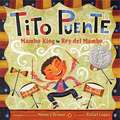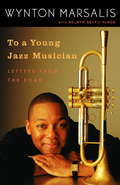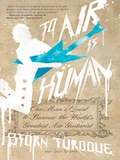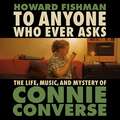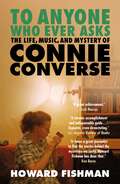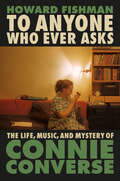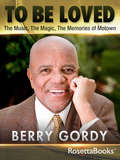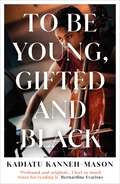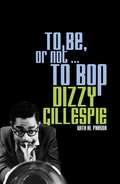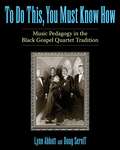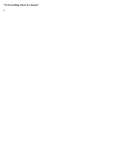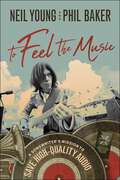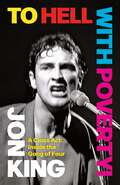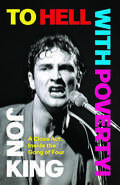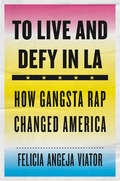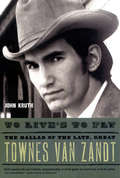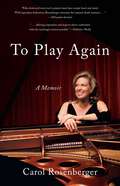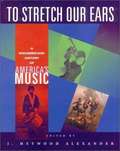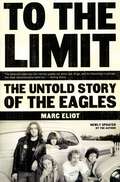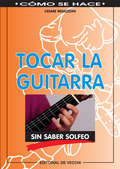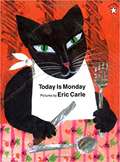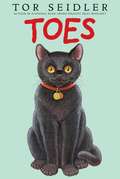- Table View
- List View
Tito Puente: Mambo King; Rey Del Mambo
by Monica Brown Rafael LopezMeet Tito Puente--the King of Mambo. Tum Tica! From musical prodigy on the streets of Harlem to five-time Grammy Award winner, Tito's life was full of rhythm. Drums and claves, saxophones and tambourines were all part of the fun. Tac Tic! Monica Brown and Rafael López, the award-winning creators of the Pura Belpré Honor Book "My Name is Celia/Me Llamo Celia," team up once again for another spectacular collaboration in this upbeat tribute to a musical legend. Tum Tic! Tom Tom! Conoce a Tito Puente, el Rey del Mambo. ¡Tum Tica! De prodigio musical en las calles de Harlem a ganador de cinco premios Grammy, la vida de Tito fue muy rítmica. Tambores y claves, saxófonos y panderetas siempre formaron parte de la diversión. ¡Tac Tic! Monica Brown y Rafael López, los creadores del libro "My Name is Celia/Me Llamo Celia," el cual fue galardonado con el Honor Pura Belpré, se reúnen una vez más para crear otra colaboración espectacular en este alegre homenaje a una leyenda musical. ¡Tum Tic! ¡Tom Tom!
To A Young Jazz Musician: Letters From The Road
by Wynton Marsalis Selwyn Seyfu HindsInTo a Young Jazz Musician,the renowned jazz musician and Pulitzer Prize—winning composer Wynton Marsalis gives us an invaluable guide to making good music–and to leading a good life. Writing from the road “between the bus ride, the sound check, and the gig,” Marsalis passes on wisdom gained from experience, addressed to a young musician coming up–and to any of us at any stage of life. He writes that having humility is a way to continue to grow, to listen, and to learn; that patience is necessary for developing both technical proficiency and your own art rather than an imitation of someone else’s; and that rules are indispensable because “freedom lives in structure. ” He offers lessons learned from his years as a performer and from his great forebears Duke Ellington, Charlie Parker, and others; he explores the art of swing; he discusses why it is important to run toward your issues, not away; and he talks about what to do when your integrity runs up against the lack thereof in others and in our culture. He poetically expresses our need for healers: “All of it tracks back to how you heal your culture, one patient at a time, beginning with yourself. ” This is a unique book, in which a great artist offers his personal thoughts, both on jazz and on how to live a better, more original, productive, and meaningful life. To a Young Jazz Musician is sure to be treasured by readers young and old, musicians, lovers of music, and anyone interested in being mentored by one of America’s most influential, generous, and talented artists. From the Hardcover edition.
To Air is Human: One Man's Quest to Become the World's Greatest Air Guitarist
by Bjorn Turoque Dan CraneHow an average musician put aside his "there" guitar and reinvented himself as Björn Türoque, the take-no-prisoners future of air guitar. <P> The true story of how mildly successful guitarist and New York Times writer Dan Crane relinquished his instrument and became Björn Türoque (pronounced "b-yorn too-RAWK"), the second greatest air guitarist in the nation. This exploration of the international air guitar sub-culture addresses the issue of dedicating oneself to an invisible art in order to achieve the ultimate goal of "airness"-that is, when air guitar transcends the "real" art that it imitates and becomes an art form in and of itself.
To Anyone Who Ever Asks: The Life, Music, and Mystery of Connie Converse
by Howard FishmanA biography of the mythic singer songwriter Connie Converse, who mysteriously disappeared after recording her debut album and was never seen again.When musician and New Yorker contributor Howard Fishman first heard Connie Converse's voice, he was convinced she could not be real. Her recordings were too out of place for the 1950s to make sense - a singer who bridged the gap between traditional Americana and the singer-songwriter movement that exploded a decade later with Bob Dylan and Joni Mitchell.Howard was determined to know more about this artist and how she slipped through the cracks of music history but there was one problem: in 1974, at the age of fifty, Connie simply drove off one day and was never heard from again.After a dozen years of research, Fishman expertly weaves a narrative of her life and music, and of how it has come to speak to him as both an artist and a person. He discovers fans who Connie's music touched deeply and still remember the lyrics to songs they'd heard only once or twice over 50 years ago.It is by turns a hopeful, inspiring, melancholy, and chilling story of dark family secrets, taciturn New England traditions, a portrait of 1950s Greenwich Village, and of a woman who fiercely strove for independence when the odds were against her. Ultimately, Fishman shows that Connie was a significant outsider artist, a missing link pre-empting the reflective, complex, arresting music that transformed the 1960s and music forever.(P) 2023 Penguin Audio
To Anyone Who Ever Asks: The Life, Music, and Mystery of Connie Converse
by Howard FishmanThe mysterious true story of Connie Converse - a mid-century New York singer and songwriter whose haunting music never gained widespread recognition - and one writer's quest to understand her life.When musician and New Yorker contributor Howard Fishman first heard a Connie Converse recording, he was convinced she could not be real. Her music was too out of place for the 1950s to make sense - a singer who bridged the gap between traditional Americana, pop standards, and the singer-songwriter movement that exploded a decade later with Bob Dylan and Joni Mitchell.Fishman was determined to know more about this artist and how she slipped through the cracks of music history but there was one problem: in 1974, at the age of fifty, Converse simply drove off one day and was never heard from again.After a dozen years of research, Fishman expertly weaves a narrative of her life and music, and of how it has come to speak to him as both an artist and a person.It is by turns a hopeful, inspiring, melancholy, and chilling story of dark family secrets, taciturn New England traditions, a portrait of 1950s Greenwich Village, of a visionary intellect and talent, and a woman who fiercely strove for independence when the odds were against her. Ultimately, Fishman places Converse in the canon as a vital, overlooked trailblazer, a missing link pre-empting the reflective, complex, arresting music that transformed the 1960s and music forever.
To Anyone Who Ever Asks: The Life, Music, and Mystery of Connie Converse
by Howard FishmanThe mysterious true story of Connie Converse—a mid-century New York City songwriter, singer, and composer whose haunting music never found broad recognition—and one writer&’s quest to understand her lifeThis is the mesmerizing story of an enigmatic life. When musician and New Yorker contributor Howard Fishman first heard Connie Converse&’s voice on a recording, he was convinced she could not be real. Her recordings were too good not to know, and too out of place for the 1950s to make sense—a singer who seemed to bridge the gap between traditional Americana (country, blues, folk, jazz, and gospel), the Great American Songbook, and the singer-songwriter movement that exploded a decade later with Bob Dylan and Joni Mitchell. And then there was the bizarre legend about Connie Converse that had become the prevailing narrative of her life: that in 1974, at the age of fifty, she simply drove off one day and was never heard from again. Could this have been true? Who was Connie Converse, really? Supported by a dozen years of research, travel to everywhere she lived, and hundreds of extensive interviews, Fishman approaches Converse&’s story as both a fan and a journalist, and expertly weaves a narrative of her life and music, and of how it has come to speak to him as both an artist and a person. Ultimately, he places her in the canon as a significant outsider artist, a missing link between a now old-fashioned kind of American music and the reflective, complex, arresting music that transformed the 1960s and music forever. But this is also a story of deeply secretive New England traditions, of a woman who fiercely strove for independence and success when the odds were against her; a story that includes suicide, mental illness, statistics, siblings, oil paintings, acoustic guitars, cross-country road trips, 1950s Greenwich Village, an America marching into the Cold War, questions about sexuality, and visionary, forward thinking about race, class, and conflict. It&’s a story and subject that is by turn hopeful, inspiring, melancholy, and chilling.
To Be Loved: The Music, the Magic, the Memories of Motown
by Berry GordyThe story of Motown Records and how it changed the course of American music, as told by its founder—&“an African American culture hero of historic stature&” (The New York Times). Berry Gordy Jr., who once considered becoming a boxer, started a record company with a family loan of $800 in 1959. Gordy&’s company, Motown Records, went on to create some of the most popular music of all time. By the time he sold the company nearly thirty years later, it was worth $61 million and had produced musical legends including Jackie Wilson, Smokey Robinson and the Miracles, the Temptations, Marvin Gaye, Diana Ross and the Supremes, Stevie Wonder, and the Jackson 5. Here, the revolutionary who shattered the color barrier in the American entertainment industry and forever changed the way the world hears music, shares his story of ambition and vision. From humble beginnings, Gordy amassed a fortune and became a musical kingmaker in the cultural heydays of the 1960s and &’70s. Quelling rumors and detailing his relationships with the artists he managed, Gordy pens &“a vivid recreation of a great period and a seminal company in popular music&” (Kirkus Reviews).
To Be Young, Gifted and Black
by Kadiatu Kanneh-MasonWhat does it mean – and how does it feel – to grow up as a Black artist today? &‘This exceptional book, written with a mother&’s love for her seven creative children, sensitively offers profound and original insights and perspectives that enrich our culture. I feel so much wiser for reading it.&’ Bernardine Evaristo When Kadiatu Kanneh-Mason&’s eldest daughter, Isata, made her solo debut at the BBC Proms in 2023, she could not have been prouder. Watching years of hard work transform into a transcendent performance was profoundly moving, both as music-lover and parent. All fractured when her younger daughter turned to her in tears a few days later, having read online abuse about her sister. Isata, it was declared, did not deserve to be there. How do you prepare your child for the fact that no matter their talent, technique or dedication, they will be told they do not belong? Through conversations with her extraordinarily gifted family, Kanneh-Mason explores what it&’s like to come of age in these turbulent times, when Black artistic self-expression is so often met with disparagement and abuse online – and offers a hopeful, powerful way through.
To Be, or Not… to Bop
by Dizzy Gillespie Al FraserThis book is a complete, authentic, and authoritative autobiography of Dizzy Gillespie (1917-1993), a jazz musician, ever published.
To Do This, You Must Know How: Music Pedagogy in the Black Gospel Quartet Tradition (American Made Music Series)
by Lynn Abbott Doug SeroffTo Do This, You Must Know How traces black vocal music instruction and inspiration from the halls of Fisk University to the mining camps of Birmingham and Bessemer, Alabama, and on to Chicago and New Orleans. In the 1870s, the Original Fisk University Jubilee Singers successfully combined Negro spirituals with formal choral music disciplines and established a permanent bond between spiritual singing and music education. Early in the twentieth century there were countless initiatives in support of black vocal music training conducted on both national and local levels. The surge in black religious quartet singing that occurred in the 1920s owed much to this vocal music education movement. In Bessemer, Alabama, the effect of school music instruction was magnified by the emergence of community-based quartet trainers who translated the spirit and substance of the music education movement for the inhabitants of working-class neighborhoods. These trainers adapted standard musical precepts, traditional folk practices, and popular music conventions to create something new and vital Bessemer's musical values directly influenced the early development of gospel quartet singing in Chicago and New Orleans through the authority of emigrant trainers whose efforts bear witness to the effectiveness of “trickle down” black music education. A cappella gospel quartets remained prominent well into the 1950s, but by the end of the century the close harmony aesthetic had fallen out of practice, and the community-based trainers who were its champions had virtually disappeared, foreshadowing the end of this remarkable musical tradition.
To Ease My Troubled Mind: The Authorized Unauthorized History of Billy Childish
by Ted KesslerThe story of Billy Childish, the most famous artist you’ve never heard of, by legendary music journalist Ted Kessler In 1977, seventeen-year-old Steven Hamper was a stonemason in the dockyards of Chatham, Kent, in England. His heart, however, beat in sync with the punk rock tremors of the era, seduced by its celebration of amateurism. So, in a gesture of revolutionary defiance, he took a three pound club hammer and smashed his hand, vowing to never work again. In doing so, Steven Hamper metamorphosed into Billy Childish, a true Renaissance man. Childish has since remained steadfastly true to punk’s DIY cred, becoming one of the most recognizable and authentic voices in whichever artistic endeavor he undertakes. He has released over 150 albums of raw rock and roll, punk, blues, and folk; and has written many volumes of searing poetry as well as several autobiographical novels. But what he is perhaps best known for in recent years is his painting, for which he is now critically, commercially, and internationally feted. He hasn’t changed course in any of his disciplines, though. The world just caught up with the sheer volume of his brutally honest work. To Ease My Troubled Mind is a mosaic portrait collated over a year of interviews with Childish, as well as with close family, ex-girlfriends, band members past and present, friends, foes, collaborators, even his therapist. It is an unflinching, yet frequently spiritual and funny portrait of an artist who is now one of the most prolific and uncompromising of his generation. The volume also includes a foreword by British comedian Stewart Lee.
To Everything There Is A Season: Pete Seeger And The Power Of Song (New Narratives In American History Ser.)
by Allan M. WinklerAuthor or coauthor of such legendary songs as "If I Had a Hammer," "Where Have All the Flowers Gone?" and "Turn, Turn, Turn," Pete Seeger is the most influential folk singer in the history of the United States. In "To Everything There Is a Season": Pete Seeger and the Power of Song, Allan Winkler describes how Seeger applied his musical talents to improve conditions for less fortunate people everywhere. This book uses Seeger's long life and wonderful songs to reflect on the important role folk music played in various protest movements of the twentieth century. A tireless supporter of union organization in the 1930s and 1940s, Seeger joined the Communist Party, performing his songs with banjo and guitar accompaniment to promote worker solidarity. In the 1950s, he found himself under attack during the Red Scare for his radical past. In the 1960s, he became the minstrel of the civil rights movement, focusing its energy with songs that inspired protestors and challenged the nation's patterns of racial discrimination. Toward the end of the decade, he turned his musical talents to resisting the war in Vietnam, and again drew fire from those who attacked his dissent as treason. Finally, in the 1970s, he lent his voice to the growing environmental movement by leading the drive to clean up the Hudson River
To Feel the Music: A Songwriter's Mission to Save High-Quality Audio
by Neil Young Phil BakerNeil Young took on the music industry so that fans could hear his music—all music—the way it was meant to be heard. Today, most of the music we hear is com-pressed to a fraction of its original sound,while analog masterpieces are turning to dustin record company vaults. As these record-ings disappear, music fans aren't just losing acollection of notes. We're losing spaciousness,breadth of the sound field, and the ability tohear and feel a ping of a triangle or a pluckof a guitar string, each with its own reso-nance and harmonics that slowly trail off intosilence. The result is music that is robbed of its original quality—muddy and flat in sound compared to the rich, warm sound artists hear in the studio. It doesn't have to be this way, but the record and technology companies have incorrectly assumed that most listeners are satisfied with these low-quality tracks. Neil Young is challenging the assault on audio quality—and working to free music lovers from the flat and lifeless status quo. To Feel the Music is the true story of his questto bring high-quality audio back to musiclovers—the most important undertaking ofhis career. It's an unprecedented look insidethe successes and setbacks of creating thePono player, the fights and negotiationswith record companies to preserve master-pieces for the future, and Neil's unrelentingdetermination to make musical art availableto everyone. It's a story that shows how muchmore there is to music than meets the ear. Neil's efforts to bring quality audio to his fans garnered media attention when his Kickstarter campaign for his Pono player—a revolutionary music player that would combine the highest quality possible with the portability, simplicity and affordability modern listeners crave—became the third-most successful Kickstarter campaign in the website's history. It had raised more than $6M in pledges in 40 days. Encouraged by the enthusiastic response, Neil still had a long road ahead, and his Pono music player would not have the commercial success he'd imagined. But he remained committed to his mission, and faced with the rise of streaming services that used even lower quality audio, he was determined to rise to the challenge. An eye-opening read for all fans of Neil Young and all fans of great music, as well as readers interesting in going behind the scenes of product creation, To Feel the Music has an inspiring story at its heart: One determined artist with a groundbreaking vision and the absolute refusal to give up, despite setbacks, naysayers, and skeptics.
To Hell With Poverty!: A Class Act: Inside the Gang of Four
by Jon KingFrom Jon King, the legendary frontman of iconic post-punk band, Gang of Four, comes a memoir to remember.To Hell With Poverty! documents Jon's story from a south London slum and working-class background to international success as core musician, lyricist, writer, and producer in acclaimed post-punk/funk band, Gang of Four. Made up of charming vignettes, the reader is taken on an episodic journey full of raucous adventures from Jon's childhood and teenage years, to the height of Gang of Four's success in the seventies and eighties.Thrown off of Top of the Pops, truncheoned by police at an anti-Nazi rally, being at the heart of the Leeds music scene and the UK postpunk movement, fraternising with Hell's Angels and other undesirables, supported by bands like R.E.M. and playing with the Buzzcocks, there's no doubt King's time with Gang of Four is rich with jaw-dropping stories.Evocative, pacey and witty in equal measure, To Hell With Poverty! is a music memoir for the ages
To Hell with Poverty!: A Class Act: Inside the Gang of Four
by Jon KingFrom Jon King, legendary front man of iconic post-punk band Gang of Four, comes a memoir to remember. TO HELL WITH POVERTY! documents King’s story from a south London slum and working-class background to international success as core musician, lyricist, writer, and producer in the legendary post-punk/funk band Gang of Four. King’s memoir takes the reader on an episodic journey full of raucous adventures from his childhood and teenage years, to the height of Gang of Four’s success in the seventies and eighties. Thrown off Top of the Pops, truncheoned by police at an anti-Nazi rally, coming of age in the heart of the Leeds music scene and the UK post-punk movement, mingling with Hells Angels and other undesirables, supported by bands like R.E.M. and playing with the likes of the Police, Iggy Pop, and the Buzzcocks—King’s time with Gang of Four is rich with jaw-dropping stories. Evocative, fast-paced, and witty, To Hell with Poverty! is a music memoir for the ages. Gang of Four’s Entertainment! LP is consistently ranked as one of the greatest debut albums of all time and continues to inspire new generations of musicians today. The band has influenced many artists, from the Red Hot Chili Peppers, Nirvana, and INXS, to 2025-era Frank Ocean, the Idles, and hip-hop giants Run the Jewels. Gang of Four have been championed by the likes of Flea, Sofia Coppola, Massive Attack, Damien Hirst, Greil Marcus, and many more.
To Live and Defy in LA: How Gangsta Rap Changed America
by Felicia Angeja ViatorIn its early days, rap was understood as the poetry of the “inner city,” which usually meant New York. Few expected anything as hard-edged as gangsta rap to emerge from Los Angeles, home of surf and sun. Felicia Viator tells the story of LA’s self-styled “ghetto reporters,” whose music forced America to see an urban crisis it preferred to ignore.
To Live's to Fly: The Ballad of the Late, Great Townes Van Zandt
by John KruthAt last, the authorized biography of Townes Van Zandt (1944-1997), who wrote such unforgettable songs as "Pancho & Lefty” and "If I Needed You.” Born to a wealthy oil family in Ft. Worth, Texas, hounded by alcoholism and depression, Van Zandt pursued a nomadic existence following his muse, whatever the cost to himself, friends, and relatives. Based on exclusive interviews with those close to Van Zandt, including his best friend Guy Clark and colleagues like Steve Earle and John Prine, To Live's to Fly captures all the humor, hijinks, poetry, and heartbreak of this revered, genuinely outlaw country artist.
To Play Again: A Memoir of Musical Survival
by Carol RosenbergerAt age twenty-one, while she was working with the legendary Nadia Boulanger in France, concert pianist Carol Rosenberger was stricken with paralytic polio—a condition that knocked out the very muscles she needed in order to play. But Rosenberger refused to give up. Over the next ten years, against all medical advice, she struggled to rebuild her technique and regain her life as a musician—and went on to not only play again, but to receive critical acclaim for her performances and recordings. Beautifully written and deeply inspiring, To Play Again is Rosenberger&’s chronicle of making possible the seemingly impossible: overcoming career-ending hardships to perform again.
To Stretch Our Ears: A Documentary History Of America's Music
by J. Heywood AlexanderTo Stretch Our Ears is the first gathering of significant and far-reaching readings that illuminate many aspects of American music.
To the Break of Dawn: A Freestyle on the Hip Hop Aesthetic
by William Jelani Cobb2007 Arts Club of Washington’s National Award for Arts Writing - FinalistSEE ALSO: Pimps Up, Ho’s Down: Hip Hop’s Hold on Young Black Women by T. Denean Sharpley-Whiting.An inside look into the beats, lyrics, and flow of hip-hop's historyWith roots that stretch from West Africa through the black pulpit, hip-hop emerged in the streets of the South Bronx in the 1970s and has spread to the farthest corners of the earth. To the Break of Dawn uniquely examines this freestyle verbal artistry on its own terms. A kid from Queens who spent his youth at the epicenter of this new art form, music critic William Jelani Cobb takes readers inside the beats, the lyrics, and the flow of hip-hop, separating mere corporate rappers from the creative MCs that forged the art in the crucible of the street jam.The four pillars of hip hop—break dancing, graffiti art, deejaying, and rapping—find their origins in traditions as diverse as the Afro-Brazilian martial art Capoeira and Caribbean immigrants’ turnstile artistry. Tracing hip-hop’s relationship to ancestral forms of expression, Cobb explores the cultural and literary elements that are at its core. From KRS-One and Notorious B.I.G. to Tupac Shakur and Lauryn Hill, he profiles MCs who were pivotal to the rise of the genre, verbal artists whose lineage runs back to the black preacher and the bluesman.Unlike books that focus on hip-hop as a social movement or a commercial phenomenon, To the Break of Dawn tracks the music's aesthetic, stylistic, and thematic evolution from its inception to today's distinctly regional sub-divisions and styles. Written with an insider's ear, the book illuminates hip-hop's innovations in a freestyle form that speaks to both aficionados and newcomers to the art.
To the Limit: The Untold Story of the Eagles
by Marc EliotThe definitive, unauthorized biography of The Eagles by the New York Times bestselling biographerTo the Limit is the unauthorized account of the group from its earliest years through the breakup, solo careers, and reunions. Blending the country and folk music of the late sixties with the melodic seductiveness of Detroit-style roots rock, the Eagles brought a new sound to a stagnant music scene. Under the brilliant management of David Geffen, the Eagles projected a public image of unshakable camaraderie -- embodied by the cerebral, brooding Don Henley and the intuitive, self-destructive Glenn Frey -- bolstered by the gorgeous harmonies of their songs. Behind the scenes, however, there was another story. At turns revealing, inspiring, funny, and shocking, To the Limit is the chronicle of a time, a place, and a group that succeeded in changing forever the world of popular music.
Tocar la guitarra sin saber solfeo
by Cesare Regazzoni* Los acordes son la base del acompañamiento musical. Una vez los haya aprendido, usted podrá desarrollar su técnica con mucha más seguridad y rapidez. Interpretar una melodía o acompañar a un cantante le será muy fácil. * En esta guía usted encontrará todos los acordes y sus respectivos «giros» o combinaciones, representados en sencillas ilustraciones en las que podrá reconocer fácilmente las cuerdas de la guitarra y la posición de los dedos. No encontrará ni un solo pentagrama, ni una nota, porque estas páginas están pensadas para que cualquier persona, aun no sabiendo solfeo, pueda aprender a tocar la guitarra. * Lo importante en este libro no es la teoría, sino la práctica, por ello sólo se dan las indicaciones más útiles y eficaces. * Un manual, en resumidas cuentas, que le ayudará a dar los primeros pasos con el instrumento más adecuado para animar las fiestas, acompañar a los amigos cuando vaya de excursión y alegrar el ambiente en muchas ocasiones Cesare Regazzoni se diplomó en el conservatorio de Parma en canto oral, instrumentos de viento y de percusión y composición con los profesores Margola y Milan. Ha grabado numerosos discos de didáctica infantil con fascículos de animación. En el año 1987 realizó para RAI 2 las bandas sonoras de seis largometrajes para el Festival de Cine de Venecia. En el año 1990 colaboró con RAI 3 en el Departamento de Escuela - Educación. Desde hace varios años trabaja y produce en su estudio personal de grabación donde ha conseguido una amplísima experiencia con el teclado electrónico.
Today is Monday
by Eric CarleA charming book to entertain young children while they learn the days of the week.
Toes
by Tor SeidlerAfter getting lost on Halloween night when he is only a few months old, an intelligent seven-toed kitten makes his way into the life of a struggling musician.
Together We Can Do It (Star Power)
by Catherine HapkaHow far will the gossip go? Star's opening act in Sweden is a local singer named Sven Studborg. The two performers get along great -- until someone starts spreading rumors about them in the press. Who could be out to spoil things for Star and Sven? Meanwhile, Star decides to fly in some friends from home for a visit. But when Aaron says he can't make the trip, Star realizes that the media gossip could have consequences that stretch far beyond her singing career.
